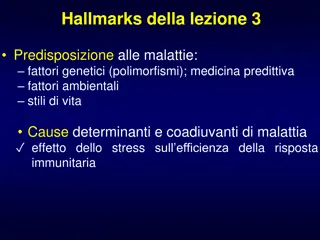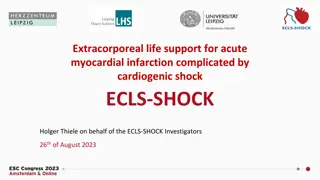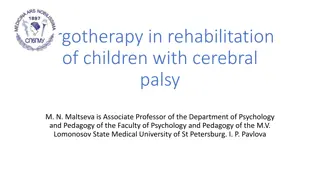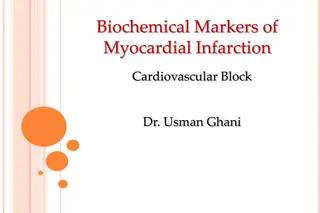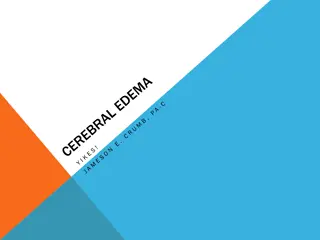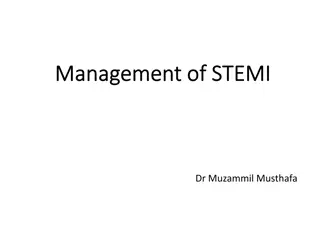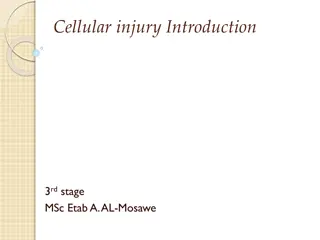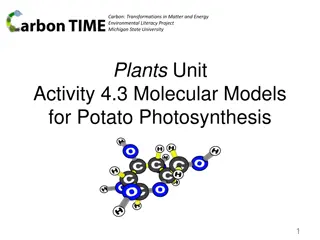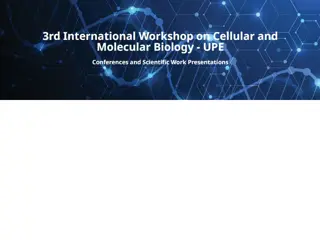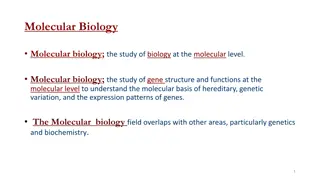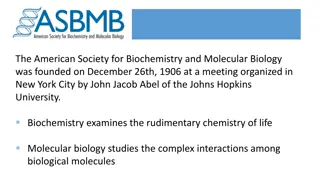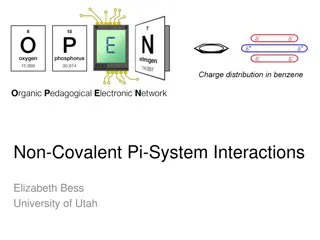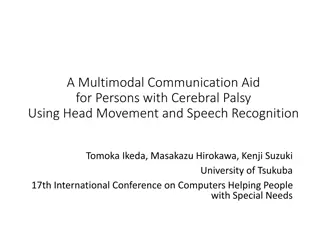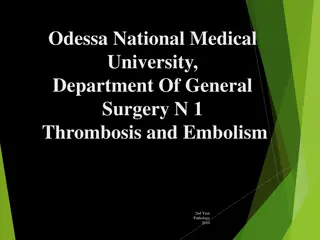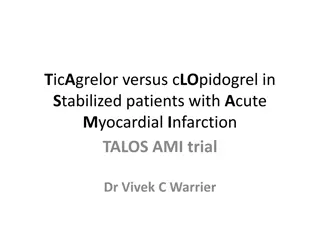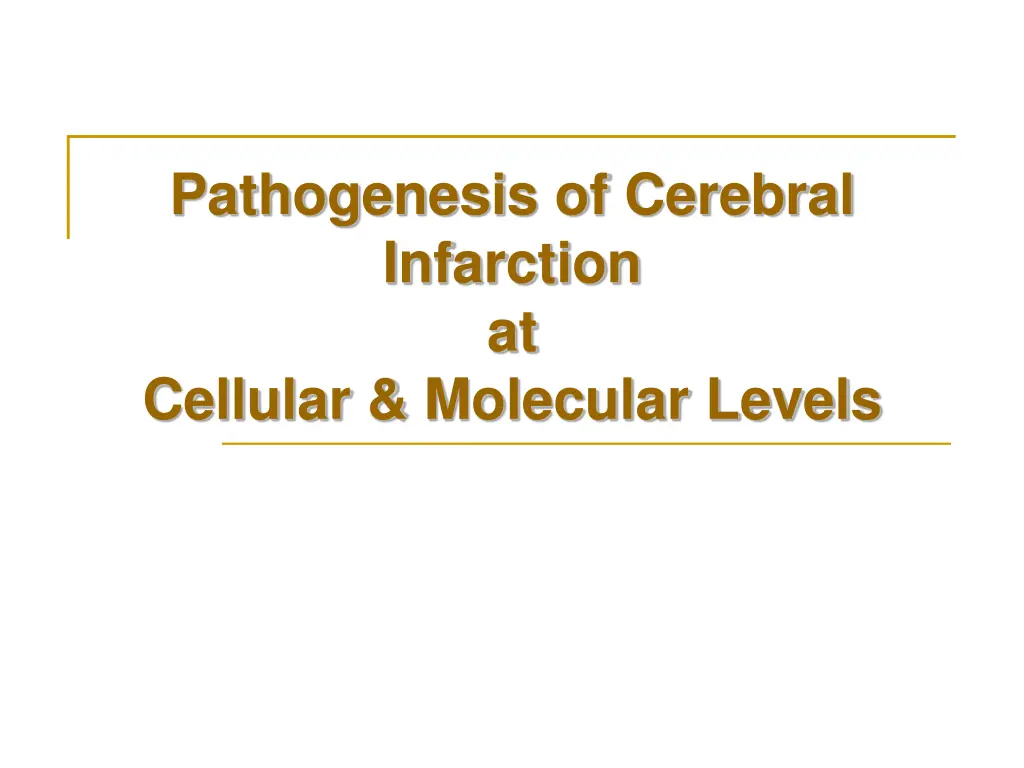
Understanding Cerebral Infarction at Cellular and Molecular Levels
Explore the pathogenesis of cerebral infarction at cellular and molecular levels, identifying cell death mechanisms, oxidative stress, metabolic factors, and neurochemical changes. Learn about the subtype and risk factors of strokes, as well as cell death mechanisms in ischemic brain injury involving necrosis and apoptosis. Gain insights into the role of calcium-induced calpain-mediated proteolysis in cerebral ischemia.
Download Presentation

Please find below an Image/Link to download the presentation.
The content on the website is provided AS IS for your information and personal use only. It may not be sold, licensed, or shared on other websites without obtaining consent from the author. If you encounter any issues during the download, it is possible that the publisher has removed the file from their server.
You are allowed to download the files provided on this website for personal or commercial use, subject to the condition that they are used lawfully. All files are the property of their respective owners.
The content on the website is provided AS IS for your information and personal use only. It may not be sold, licensed, or shared on other websites without obtaining consent from the author.
E N D
Presentation Transcript
Pathogenesis of Cerebral Infarction at Cellular & Molecular Levels
Objectives: By the end of this lecture, the students should be able to: Identify the possible cell death mechanisms implicated in the pathogenesis of ischemic brain injury Acquire the knowledge of the important role played by oxidative stress and free radicals in the pathogenesis of cerebral infarction Understand the various factors involved in ischemia-induced metabolic stress Identify the Neurochemical changes involved in cerebral ischemia
Cerebral Ischemia (Strokes) subtypes Stroke Global incidence: 68% Global incidence: 32% Hemorrhagic Ischemic Intracerebral Thrombotic Subarachnoid Embolic http://www.uptodate.com/contents/overview-of-the-evaluation-of-stroke
Risk factors of strokes There are a number of risk factors for stroke: Some increase the risk of one type of stroke (hemorrhagic or ischemic). Some increase the risk of both types. Occasionally, strokes occur in people who have no risk factors. Continued ...
Risk factors of strokes Ischemic stroke risk factors Age older than 40 years Heart disease High blood pressure Smoking Diabetes High blood cholesterol levels Illegal drug use Recent childbirth Previous history of transient ischemic attack Inactive lifestyle and lack of exercise Obesity Current or past history of blood clots Family history of cardiac disease and/or stroke Hemorrhagic stroke risk factors High blood pressure Smoking Illegal drug use (especially cocaine and "crystal meth") Use of warfarin or other blood thinning medicines
The cell death mechanisms implicated in the pathogenesis of ischemic brain injury
Cell death mechanisms in cerebral ischemia: Necrosis and Apoptosis Necrosis is commonly observed early after severe ischemic insults Apoptosis occurs with more mild insults and with longer survival periods The mechanism of cell death involves calcium-induced calpain-mediated proteolysis of brain tissue Substrates for calpain include: Cytoskeletal proteins, Membrane proteins and Regulatory and signaling proteins
Biochemical Responses to Ischemic Brain Injury Oxidative stress Metabolic stress Neurochemical response
The Role of Reactive Oxygen Species (ROS) & Reactive Nitrative Species (RNS) in Normal Brain Physiology They are mainly generated by microglia & astrocytes They modulate synaptic transmission & non-synaptic communication between neurons & glia During periods of increased neuronal activity, ROS & RNS diffuse to the myelin sheath of oligodendrocytes activating Protein kinase C (PKC) posttranslational modification of myelin basic protein (MBP) by phosphorylation They regulate neuronal signaling in both central & peripheral nervous systems They are required for essential processes as learning & memory formation
Oxidative stress A condition in which cells are subjected to excessive levels of Reactive oxidizing species (ROS or RNS) & they are unable to counterbalance their deleterious effects with antioxidants. It has been implicated in the ageing process & in many diseases (e.g., atherosclerosis, cancer, neurodegenerative diseases, stroke)
The brain and Oxidative stress The brain is highly susceptible to ROS-induced damage because of: High concentrations of peroxidisable lipids Low levels of protective antioxidants High oxygen consumption High levels of iron (acts as pro-oxidants under pathological conditions) The occurrence of reactions involving dopamine & Glutamate oxidase in the brain
Molecular & Vascular effects of ROS in ischemic stroke Molecular effects: DNA damage Lipid peroxidation of unsaturated fatty acids Protein denaturation Inactivation of enzymes Cell signaling effects (e.g., release of Ca2+from intracellular stores) Cytoskeletal damage Chemotaxis Vascular effects: Altered vascular tone and cerebral blood flow Increased platelet aggregability Increased endothelial cell permeability
The role of NO in the pathophysiology of cerebral ischemia Ischemia abnormal NO production This may be both beneficial and detrimental, depending upon when and where NO is released NO produced by endothelial NOS(eNOS) improving vascular dilation and perfusion(i.e. beneficial). In contrast, NO production by neuronal NOS(nNOS) or by the inducible form of NOS(iNOS) has detrimental (harmful) effects. Increased iNOS activity generally occurs in a delayed fashion after brain ischemia and trauma and is associated with inflammatory processes
Biochemical changes in The brain during ischemia Ischemia interruption or severe reduction of blood flow, O2& nutrients in cerebral arteries energy depletion (depletion of ATP & creatine phosphate) Lactic acid in neurons acidosis promotes the pro- oxidant effect the rate of conversion of O2.-to H2O2or to hydroxyperoxyl radical Inhibition of ATP-dependent ion pumps Membranes depolarization Perturbance of transmembrane ion gradients Ca2+Influx activation of cellular proteases (Calpains) & lipases breakdown of cerebral tissue Na+influx K+efflux (translocation from extracellular to intracellular spaces) K+-induced release of excitatory amino acids
Sources & consequences of increased cytosolic Calcium in cell injury
The neurochemical response to cerebral ischemia Following cerebral ischemia, extracellular levels of various neurotransmitters are increased e.g., Glutamate Glycine GABA Dopamine
The Blood tests in patients with brain ischemia or hemorrhage Complete blood count, including hemoglobin, hematocrit, white blood cell count, and platelet count Prothrombin time, international normalized ratio (INR), and activated partial thromboplastin time Thrombin time and/or ecarin clotting time if patient is known or suspected to be taking a direct thrombin inhibitor or a direct factor Xa inhibitor Blood lipids, including total, high-density lipoprotein (HDL), and low-density lipoprotein (LDL) cholesterol, and triglycerides. Cardiac enzymes and troponin http://www.uptodate.com/contents/overview-of-the-evaluation-of-stroke
Biochemical basis of pharmacological intervention
Examples of Potential Biochemical Intervention in Cerebral Ischemia Inhibitors of glutamate release Ca2+channel blockers Nitric oxide synthase inhibitors & free radical inhibition Calpain inhibitors
Ischemic cascade Lack of oxygen supply to ischemic neurones ATP depletion Malfunctioning of membrane ion system Depolarisation of neurones Influx of calcium Release of neurotransmitters, activation of proteases Further depolarisation of cells Further calcium influx
Cosequences of brain ischemia Energy failure / depolarisation / Oxidative stress Neurotransmitter release and receptor activation Ca2+ Protein Proteolysis Lipolysis (DAG PKC ) phosphorylation Breakdown of cytoskeleton (FFAs ) Dysfunction of receptors and ion channels Membrane damage Inhibition of axonal transport, blebbing
Take Home Message Severe cerebral ischemic insults lead to a complex cascade of biochemical and molecular events, including: 1. Cell death 2. Oxidative stress 3. Metabolic stress and neurochemical changes
References Lippincott s Illustrated reviews: Biochemistry 6thedition, Unit 2, Chapter 13, Pages 145-156. Role of Oxidative Stress in Chronic Diseases (Book). (Link) The Role of Neurotransmitters in Brain Injury (Book, Page 36). (Link) http://www.uptodate.com/contents/stroke-symptoms-and-diagnosis-beyond-the- basics Bramlett and Dietrich, Pathophysiology of Cerebral Ischemia and Brain Trauma: Similarities and Differences, Journal of Cerebral Blood Flow and Metabolism, 2004, 24: 133-150 Allen and Bayraktutan, Oxidative Stress and its Role in the Pathogenesis of Ischemic Stroke, World Stroke Organization International Journal of Stroke, 2009, 4:461 470

